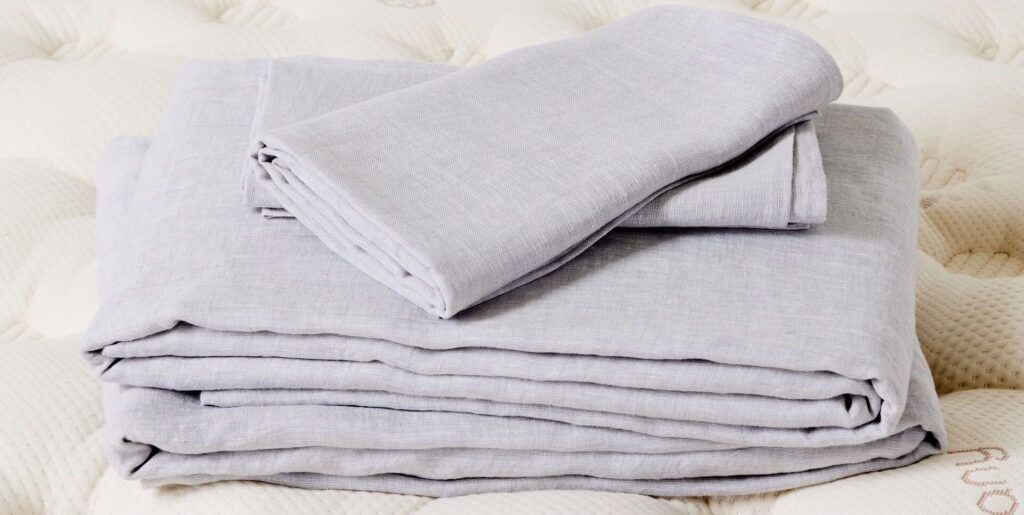
It’s recommended to replace bed sheets every two to three years and properly maintain them to avoid buildup of dust mites, allergens, body oils, and dead skin cells. Tips for extending the lifespan of sheets include buying high-quality materials, rotating between multiple sets, following maintenance instructions, and storing them properly. Sheets should be washed once a week or every other week. Signs that it may be time to replace sheets include yellowing or discoloration, thinning fabric, fraying edges, loss of elasticity in fitted sheets, and stains that can’t be washed out.
It’s important to replace your sheets every two to three years—and to properly maintain them. That’s because over time, your sheets can take on a lot of buildup, including such unpleasantries as dust mites, allergens, body oils, and dead skin cells. Ew!
Bed sheets can play a huge role in your quality of sleep at night. They’re a great way to regulate temperature and customize your bed’s comfort. So you’ll want to make sure you’re taking care of them the right way and replacing them when needed.
Keep reading to learn how to make your bed sheets last longer, the proper way to clean them, and signs it’s time to replace your sheets.
Tips to make your bed sheets last longer
Even though you should replace your bed sheets every two to three years, there are some things you can do to extend their lifespan. In fact, their lifespan is heavily based on the quality of the material you choose and whether you follow the proper maintenance.
Here are four of our top tips for extending the lifespan of your sheets:
1. Buy sheets made of high-quality materials
The quality of your bed sheets often plays a huge role in how long they’ll last. To determine their quality, there are a few things you should look at, including material. Some of the highest quality sheets include:
- Cotton sheets: This material is durable, lightweight, and breathable—which makes it perfect for hot sleepers. Cotton sheets are fairly affordable compared to other materials and provide an ultra-soft and comfortable feel.
- Percale sheets: Percale is a tight-knit cotton fabric with a light and airy feel.Percale sheetsare great in all weather and can last a long time. Besides that, this fabric gets softer every time you take it out of the washing machine.
- Sateen sheets:Sateen sheetsprovide a similar feel to satin but are much less temperamental. You can get the same shiny look and wrinkle resistance but they’re less expensive and easier to care for than satin.
- Linen sheets:Linen sheetsare great for those looking for a set of cooling sheets. They have excellent airflow in addition to a soft and comfy feel. They’re also hypoallergenic and moisture-wicking.
In addition to the actual type of material they’re made of, you should pay attention to the thread count of your sheets. But it’s important to point out that a higher thread count doesn’t always equate to better quality sheets. The best thread count for percale sheets, for example, is between 200-400, while it’s between 300-600 for sateen sheets.
2. Cycle through multiple sets of sheets
One of the top ways to extend the lifespan of your bed sheets is to rotate through a few different sets of sheets at a time—so that while you’re washing one set of sheets, you can put the other on your bed.
This ensures you’re properly cleaning and maintaining your bed sheets to reduce bacteria and buildup while making sure you aren’t wearing down your sheets too quickly.
Rotating between two or three different sets of sheets will also allow you to customize the feel of your bed for the weather. You can use cooling sheets in the summer while using cozier sheets in the winter.
3. Follow maintenance instructions
While your maintenance routine will heavily depend on the specific material your sheets are made of, we can provide some basic tips to help you care properly for them.
For example, bed sheets usually need to be washed with warm water. Hot water is harsh on colors and may fade your sheets quickly, while cold water may not clean your sheets as well as you would like.
You should also use a very gentle detergent when washing sheets. This will help reduce fraying and overall damage.
Lastly, if your bed sheets can be put in the dryer, you should ensure that it’s on the lowest heat setting possible. Some materials, however, may require a line-dry instead. (This is the best way to whiten sheets.)
4. Make sure they are stored properly
A great way to help extend the life of your sheets is to store them properly when they aren’t being used. This can help reduce the presence of dust mites, minimize wrinkles, and allow them to properly breathe.
The best place to store your sheets is in a dedicated linen closet. But this isn’t always possible, especially if you live in a small space.
Any dry space that gets airflow will do as well. We recommend storing your sheets in a dedicated bin (with a lid) to help reduce allergens and other bacteria. You can also use a breathable bag.
How often should you wash your sheets?
Sheets should be washed once a week or once every other week. This will keep both your top sheet and fitted sheet fresh and ensure they don’t wear down too quickly. (Does your fitted sheet always slip? Here’s how to keep your sheets on your bed.)
Having clean sheets can help reduce the presence of body oils, dead skin cells, and allergens. This can help reduce acne and allergy symptoms throughout the day.
But you should aim to strike a balance between proper maintenance and frequent washing. Washing your sheets too often can wear down the material—but washing too infrequently can lead to their becoming soiled quickly.
Signs it may be time to replace your sheets
A set of new bed sheets can help you sleep better and feel more comfortable at night. But how, exactly, can you tell when it’s time to get a new set? There are a few key indicators that may mean you need new sheets, including:
- You notice yellowing or discoloration
- The fabric is starting to thin
- The edges are fraying
- Your fitted sheet is losing elasticity
- There are stains you can’t wash out
Having dirty sheets on your bed for too long can also make your blankets, duvet cover, and mattress dirty as well. To extend the life of all your bedroom products, it’s important to replace your sheets when it becomes necessary—or at least every two to three years, whichever comes first.
Shop high-quality sheets, pillowcases, and bed accessories with Saatva
Remember, you should aim to replace your sheets every two to three years and wash them once per week or every other week for the best quality sleep.
When you’re looking for new sheets, keep in mind that Saatva offers a large line of bed sheets, mattresses, and other bed accessories that are perfect for upgrading your bedroom.
If you’re in the market for a new bed and looking to upgrade your sleep space, check out Saatva’s high-quality bedding and take our online mattress quiz.
John-Manuel Andriote
John-Manuel Andriote began writing about health and medicine while working on a master’s degree in journalism at Northwestern University in the mid-1980s. He is the author of six books, including an award-winning history of the HIV-AIDS pandemic, a book focused on building resilience, and a “fable for kids ages 5 to 105” based on the true story of a runaway cow in Andriote’s home state of Connecticut. He has contributed articles to newspapers and magazines ranging from The Atlantic to The Washington Post. He writes the “Stonewall Strong” blog focused on resilience for Psychology Today. Andriote since August 2021 has been the senior writer for Winship Cancer Institute of Emory University, in Atlanta, Georgia.






